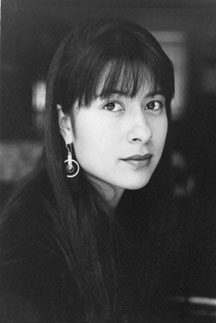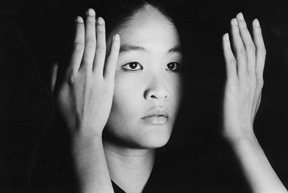

ON THE SPOT:
KIMI TAKESUE talks about "BOUND"
and her EXPERIENCE
by PHAM CHI 
Kathy Geritz, UC Berkeley

Editor's note: Kimi Takesue's short film "Bound", shown together with two other short films under the same billing Within You, Without You at this year's Mill Valley Film Festival, should not be confused with Bound, a feature film currently in wide release and starring Jennifer Tilly and Gina Gershon. (LNA)

 |
| An experience of displacement: Kimi Takesue, a young Amerasian film director. |
Every year, in the beautiful pastoral hills of Mill Valley of Marin County, there's a prestigious Film Festival which features films from around the world. But not every year is there an intriguing and profound Asian American film.
It is well known that the neighboring annual San Francisco International Asian American Film Festival is a forum for works by Asian or Asian American directors.
In March of this year, I had the double pleasure of attending the West Coast premieres of Tr�n Anh H�ng's second international success, "Cyclo," at the opening night, and Carma Hinton's "The Gate of Heavenly Peace" at the closing ceremony. In between, films such as the short "The Yellow Lotus" about today's Vietnam and "The Tale of Ki�u", a feature by a Vietnamese American female director based on a famous classic, were also presented to a culturally and ethnically diverse audience. But, despite "Cyclo" and "The Gate...," I still felt, at that time, that there was something missing. A profound short film that could say more, or show us more in 10 or 15 minutes on similar topics concerning cultural identity and self-discovery, cultural assimilation and reconciliation.
Half a year later, at the 19th annual Mill Valley Film Festival, I discovered such a film, entitled "Bound," by Kimi Takasue. The Mill Valley Film Festival features eleven days of internationally renowned film, video and new media works, as well as the children's film fest and special tributes. Just by sheer chance, while leaving the Festival Caf� in the courtyard of the Outdoor Art Club, I bumped into a very charming young woman, to say the least. So, on a Saturday night, directly across from the Sequoia Theatre, the "Asian" writer-reporter met the "Asian" film director on her first Northern Californian trip and her first step to an exciting film career.
 |
| To maintain and to escape from one's identity: Michelle Lee as a woman in cultural struggle ("Bound", 1996). Photo by Anthony Lam. |
The next afternoon, on Sunday October 6th, I drove up the regular 62 miles from San Jose to see her first film "Bound", the lyrical story of a young Chinese-British woman who undertakes a symbolic journey of self-discovery. Incorporating elements of poetry and dance within a dramatic narrative, "Bound" explores one woman's attempt to reconcile the past with the present as she confronts the complexities of her cultural identity and memory.
Seated at an outdoor cafe table near the Sequoia Twin Theatres in downtown Mill Valley, Kimi Takesue and I talked about "Bound."
But first, a few words on her background.
Kimi, a fourth generation Japanese-American raised in Hawai'i and Massachusetts, produced "Bound" while living and studying in London. Funded by the Arts Council of England, "Bound" drew upon her interest in cultural studies, photography and dance based work. Although it is her first film, "Bound" has been broadcast on PBS (WHYY-12, Philadelphia) and has screened internationally at numerous festivals, including the Seattle International Film Festival, Hawai'i International Film Festival, Philadelphia Festival of World Cinema, Women in the Director's Chair 1996 National Tour, the Institute of Cultural Art in London, the Kino International Film Festival in the UK, and the New England Film and Video Festival in Boston, where it received the DuArt Outstanding Student Award. Kimi Takesue is currently in the MFA Program in Film and Media Arts at Temple University completing her latest film, "Rosewater," which was awarded a grant from the Pennsylvania Council of the Arts. A collaboration with two other Philadelphia based film makers on a future project, a 16 mm short, and a color documentary on Vietnam, "Heaven's Crossroad," are in the works.
"I was living in London at the time," Kimi explained, "and observed the Asian diaspora as applied to a London context." Thus, the cloth is a central metaphor and should try to explain "how a woman reconcile a relationship to her cultural past, and how a distant history can dramatically impact someone in the present."
Following is a more insightful discussion in Q&A format.
Q: "Tell me, please, about the woman you chose. Why Chinese and not Japanese ?"
A: "I knew you would ask that question! (laughing). I was living in London at the time and was interested in exploring the Asian diaspora as it applied to a London context, with its large Chinese-British community from Hong Kong. But the film is also using a symbolic language, and the central metaphor of "wrapping" to examine how a woman reconciles her relationship to a cultural past or a distant history which still dramatically impacts the present. I concentrated on a British/Chinese experience so I could use this central theme of "wrapping" to comment on an experience of displacement, the history of foot-binding and the woman's simultaneous struggle to maintain and escape from her identity."
Q: "Is that what you mean by �Bound' ?"
A: "Bound refers to movement and containment simultaneously. The woman is bound for a journey towards self-discovery. But she is also faced with a dilemma which threatens to entrap her and prevent her from moving and reaching her goals. In a sense, she wants to escape from her identity as a Chinese-British woman and yet she relies on that identity, that "wrapping," to give her a sense of self definition, of who she is. But at what point does that "wrapping" or identity become strangulating and actually prevent growth or movement ?"
Q: "The male character in the film looked rather Amerasian to me. Tell me something about him, please."
A: "I'm impressed that you noticed he's half Asian. Not many people see it but it definitely alters the reading of the film. I wanted to present the male figure, played by Andrew Mallet, as someone who is elusive " he has a certain femininity to him and an ambiguous ethnicity. I think this choice adds depth to their struggle that then ensues between him and the woman character, played by Michelle Lee, a Chinese-British actress living in London. In many ways, their struggle emerges from their desire to understand one another or communicate."
Q: "Now, the very necessary, albeit boring question: What's the budget ?"
A: "This was a very inexpensive project. The production crew consisted of myself and one other person, Andre Genisky. We were extremely economical and shot on video, and then transferred to 16mm film so the initial costs were very low. I received a post-production grant from the Arts Council of England for post-production expenses which totaled about 5,500 dollars."
Q: "Tony Lam. You thanked him in the final credits for the still photos. Who's he ?"
A: "He's an excellent Chinese-British photographer living in London. I love his stills."
Q: "Do you think that a lot of movies nowadays are predictable. No more avant-garde stuff ?"
A: "Yes, I am very aware of the regular trend, even among the independent movies. People keep making predictable movies. And the Hollywood-style happy endings... There are so few controversial artistic works."
Q: "Which film director do you admire ? Any mentor ?"
A: "Krzysztof Kieslowski, Atom Egoyan, Tr�nh T. Minh-H�, John Sayles, and of course, among the more renowned Asian ones, Kurosawa and Zhang Yimou, to name a few."
Q: "The foot of the "Bound" woman, and the fetishist scene in "Cyclo," the close-ups of the face and facial expressions, or lack thereof. Please compare."
A: "I'm very flattered that you have drawn a parallel between my work and Tr�n Anh H�ng's. I haven't seen "Cyclo" yet, but I have seen his earlier work and really admire his sense of visual poetry and lyricism."
Q: "Does this mean that you have a similar direction artistically ?"
A: "I have a strong interest in cinematography and tend to use a poetic and symbolic language within my work, though I'm now experimenting with different styles" deviating from the path, like some of Tr�nh th� Minh H�'s works. Dance also interests me, since that's a part of my educational background."
Q: "What are you currently working on ?"
A: "I'm in post production of a short experimental film entitled "Rosewater" and in development on a feature film entitled "Pick-Up" " a fantasy in three parts " (a trilogy � la Kryzyztof Kieslowski ?)" which is a collaboration with two other Philadelphia based filmmakers. I'm also in post-production of a color video documentary on Viet-Nam entitled "Heaven's Crossroad" which is structured as a series of poetic vignettes."
Q: "When did you travel to Viet-Nam ?"
A: "Just last year. I traveled for three months, primarily through the North of Viet-Nam. It was a wonderful experience."
Time ran out on us. What else can I say ? Fantastic, Kimi ! Thanks so much for the opportunity. Do find and maintain your true artistic independence. And may all your future days be very fulfilling !
I am intentionally putting my reflections at the end of this article, so the reader can enjoy the previous interview to the fullest. P.C.
I usually set different standards when analyzing and appreciating short movies. Like a 3-minute song rather than a symphony, a short usually brings the viewer directly and quickly to the main issue, right into focus with the leitmotiv. This short film views culture, and especially Asian culture, through an Asian-American or Asian-British woman's eyes. In this case, it is clearly her cultural internal dilemma, her ambiguity and silent suffering, followed by ultimate reconciliation of identity and memory. As the story progresses, the protagonists become more intriguing and complex, especially for a Westerner not familiar with the inner fights of a person with Asian roots, now faced with the realities of Western life.
To be honest, I was quite perplexed during the first minutes, since I wanted to come unprepared for this short film, and thus, be able to absorb and gain the "first fresh impressions." Slowly and inexorably, I then became immersed into the drama, almost becoming veiled by the cloth, now an intrinsic part of the "wrapping" constellation.
With regard to the cinematography, I particularly liked the close-ups, since some of them reflect the typical style of Akira Kurosawa and Tr�n Anh H�ng. The poetry of the images, especially the slow-motions and stills in the classic black-and-white style, do remind me of the "film noir" genre, engulfing me in the thrill of a "Casablanca" or "The Third Man."
I just wish that this short film had a stronger musical score to make it perfect. Nevertheless, Kimi Takesue's first product should be a valuable addition not only to cultural classes and women's studies seminars, but also, and absolutely, to any graduate visual art project.
"Bound," Kimi's very first movie (length: 15 minutes and 20 seconds), is a black-and-white film also available on 16 mm and VHS format. 
